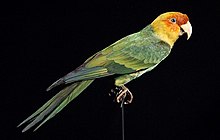
Back ببغاء كارولينا Arabic Zertekos (Conuropsis) AVK Karolin tutuquşusu Azerbaijani Каралінскі папугай Byelorussian Каролински папагал Bulgarian Aratinga de Carolina Catalan Conuropsis carolinensis CEB Papoušek karolinský Czech Karolinasittich German Karolina konuro Esperanto
| Carolina parakeet | |
|---|---|

| |
| Mounted specimen in the Naturalis Biodiversity Center | |
| Scientific classification | |
| Domain: | Eukaryota |
| Kingdom: | Animalia |
| Phylum: | Chordata |
| Class: | Aves |
| Order: | Psittaciformes |
| Family: | Psittacidae |
| Tribe: | Arini |
| Genus: | †Conuropsis Salvadori, 1891 |
| Species: | †C. carolinensis
|
| Binomial name | |
| †Conuropsis carolinensis | |
| Subspecies | |
|
C. c. carolinensis | |
| Synonyms | |
|
Psittacus carolinensis Linnaeus, 1758 | |
The Carolina parakeet (Conuropsis carolinensis), or Carolina conure, is an extinct species of small green neotropical parrot with a bright yellow head, reddish orange face, and pale beak that was native to the Eastern, Midwest, and Plains states of the United States. It was the only indigenous parrot within its range, and one of only three parrot species native to the United States. The others are the thick-billed parrot, now extirpated,[3] and the green parakeet, still present in Texas;[4] a fourth parrot species, the red-crowned amazon, is debated.[5][6][7] It was called puzzi la née ("head of yellow") or pot pot chee by the Seminole and kelinky in Chickasaw.[8] Though formerly prevalent within its range, the bird had become rare by the middle of the 19th century. The last confirmed sighting in the wild was of the C. c. ludovicianus subspecies in 1910. The last known specimen, a male named Incas, perished in captivity at the Cincinnati Zoo in 1918,[9][10] and the species was declared extinct in 1939.
The earliest reference to these parrots was in 1583 in Florida reported by Sir George Peckham in A True Report of the Late Discoveries of the Newfound Lands of expeditions conducted by English explorer Sir Humphrey Gilbert, who notes that explorers in North America "doe testifie that they have found in those countryes; ... parrots". They were first scientifically described in English naturalist Mark Catesby's two-volume Natural History of Carolina, Florida and the Bahama Islands published in London in 1731 and 1743.
Carolina parakeets were probably poisonous – French-American naturalist and painter John J. Audubon noted that cats apparently died from eating them, and they are known to have eaten the toxic seeds of cockleburs.[11][12]
- ^ BirdLife International (2021). "Conuropsis carolinensis". IUCN Red List of Threatened Species. 2021: e.T22685776A195444267. doi:10.2305/IUCN.UK.2021-3.RLTS.T22685776A195444267.en. Retrieved 20 November 2022.
- ^ "NatureServe Explorer 2.0". explorer.natureserve.org. Retrieved 31 March 2022.
- ^ Cite error: The named reference
usfwstbp2012was invoked but never defined (see the help page). - ^ Cite error: The named reference
tamugpwas invoked but never defined (see the help page). - ^ Cite error: The named reference
tamurcpwas invoked but never defined (see the help page). - ^ Cite error: The named reference
shackelford2016was invoked but never defined (see the help page). - ^ BirdLife International (2021). "Amazona viridigenalis". IUCN Red List of Threatened Species. 2021: e.T22686259A152441187. Retrieved 20 November 2022.
- ^ Snyder, Noel F.; Russell, Keith (2002). Poole, A.; Gill, F. (eds.). "Carolina Parakeet (Conuropsis carolinensis)". The Birds of North America. 667. Philadelphia, PA: The Birds of North America, Inc. doi:10.2173/bna.667.
- ^ Tallman, Dan A.; Swanson, David L.; Palmer, Jeffrey S. (2002). Birds of South Dakota. Midstates/Quality Quick Print. p. 181. ISBN 0-929918-06-1.
- ^ "The last Carolina Parakeet". John James Audubon Center at Mill Grove. 22 December 2015. Retrieved 30 October 2018.
- ^ Birkhead, Tim (2012). Bird Sense: What It's Like to Be a Bird. New York: Walker & Company. p. 123. ISBN 978-0-8027-7966-3.
- ^ Phillips, Kristin Elise. "Plumes of Poison". Audubon Magazine. Archived from the original on 28 January 2016. Retrieved 8 August 2015.
© MMXXIII Rich X Search. We shall prevail. All rights reserved. Rich X Search

